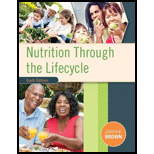
Nutrition Through the Life Cycle (MindTap Course List)
6th Edition
ISBN: 9781305628007
Author: Judith E. Brown
Publisher: Cengage Learning
expand_more
expand_more
format_list_bulleted
Question
Chapter 17, Problem 2RQ
Summary Introduction
To discuss: Three things that differentiate population recommendations to minimize cardiovascular disease risk from therapeutic lifestyle changes for individuals at high risk.
Introduction: Cardiovascular diseases (CVDs) refer to diseases that are related to heart and blood vessels. The risk factors include dyslipidemia, high blood pressure, physical inactivity, lifestyle factors related to diet, and smoking.
Expert Solution & Answer
Want to see the full answer?
Check out a sample textbook solution
Chapter 17 Solutions
Nutrition Through the Life Cycle (MindTap Course List)
Ch. 17 - Prob. 1.1CSCh. 17 - Prob. 1.2CSCh. 17 - Prob. 1.3CSCh. 17 - Prob. 1.4CSCh. 17 - Prob. 1.5CSCh. 17 - Prob. 1.6CSCh. 17 - Prob. 1.7CSCh. 17 - Prob. 2.1CSCh. 17 - Prob. 2.2CSCh. 17 - Prob. 2.3CS
Ch. 17 - Prob. 2.4CSCh. 17 - Prob. 1RQCh. 17 - Prob. 2RQCh. 17 - Prob. 3RQCh. 17 - Prob. 4RQCh. 17 - Prob. 5RQCh. 17 - Prob. 6RQCh. 17 - What nutrition-related concerns develop as a...Ch. 17 - Prob. 8RQCh. 17 - Prob. 9RQCh. 17 - Prob. 10RQCh. 17 - Prob. 11RQCh. 17 - Prob. 12RQCh. 17 - Prob. 13RQCh. 17 - Prob. 14RQ
Knowledge Booster
Similar questions
Recommended textbooks for you
 Nutrition Through The Life CycleHealth & NutritionISBN:9781337919333Author:Brown, Judith E.Publisher:Cengage Learning,
Nutrition Through The Life CycleHealth & NutritionISBN:9781337919333Author:Brown, Judith E.Publisher:Cengage Learning, Issues and Ethics in the Helping Professions (Min...NursingISBN:9781337406291Author:Gerald Corey, Marianne Schneider Corey, Cindy CoreyPublisher:Cengage Learning
Issues and Ethics in the Helping Professions (Min...NursingISBN:9781337406291Author:Gerald Corey, Marianne Schneider Corey, Cindy CoreyPublisher:Cengage Learning- Surgical Tech For Surgical Tech Pos CareHealth & NutritionISBN:9781337648868Author:AssociationPublisher:CengageEssentials of Pharmacology for Health ProfessionsNursingISBN:9781305441620Author:WOODROWPublisher:CengageUnderstanding Health Insurance: A Guide to Billin...Health & NutritionISBN:9781337679480Author:GREENPublisher:Cengage

Nutrition Through The Life Cycle
Health & Nutrition
ISBN:9781337919333
Author:Brown, Judith E.
Publisher:Cengage Learning,


Issues and Ethics in the Helping Professions (Min...
Nursing
ISBN:9781337406291
Author:Gerald Corey, Marianne Schneider Corey, Cindy Corey
Publisher:Cengage Learning

Surgical Tech For Surgical Tech Pos Care
Health & Nutrition
ISBN:9781337648868
Author:Association
Publisher:Cengage

Essentials of Pharmacology for Health Professions
Nursing
ISBN:9781305441620
Author:WOODROW
Publisher:Cengage

Understanding Health Insurance: A Guide to Billin...
Health & Nutrition
ISBN:9781337679480
Author:GREEN
Publisher:Cengage